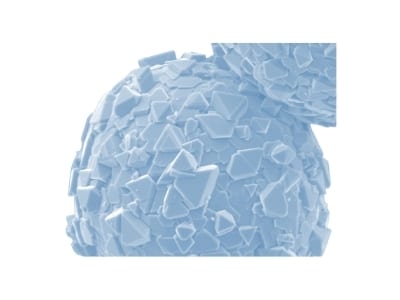

Cracking becomes more pronounced in Ni-rich cathodes because deeper delithiation produces more severe phase transitions and anisotropic volume change 33. This heterogeneous volume change breaks contact between randomly oriented primary particles and when combined with lattice strain, leads to chemomechanical breakdown in the form of intergranular and intragranular cracking, respectively 10, 29, 30, 31, 32. It has been revealed from recent operando studies that anisotropic volume change in primary particles and lattice strain initiate the mechanical destruction of secondary particles 19, 24, 25, 26, 28.
NMC CATHODE SINTERIZING CRACK
As a result, particle crack suppression is of particular significance for cycle stability in Ni-rich NMC and for most layered oxide cathodes 27. Once cracking occurs, electronic transport pathways will be blocked and fresh surfaces will be exposed to the electrolyte, which reduces the efficacy of protective surface measures and induces additional surface parasitic reactions 24, 25, 26. Although these surface protections have shown promise for stabilizing the surface chemistry, negligible improvements to the mechanical properties and no reductions in particle cracking have been realized. Strategies to resolve surface chemical instability that usually accompany parasitic reactions, irreversible phase transition, and electrolyte decomposition include the use of coatings and other surface protection techniques 13, 16, 20, 21, 22, 23. Gathered evidence reveals that the capacity degradation of Ni-rich NMC is typically attributed to surface chemical instability and mechanical destruction in the form of microcracks 14, 15, 16, 17, 18, 19. In order to surpass these limitations, much effort has been made to investigate the intrinsic properties of Ni-rich NMC and mechanisms for fast capacity fade 9, 10, 11, 12, 13. Despite the benefits to capacity however, increasing Ni content significantly exacerbates capacity degradation, which greatly restricts large-scale commercialization of Ni-rich NMC 6, 7, 8. Nickel-rich-layered oxides (LiNi xMn 圜o zO 2 Ni-rich NMC x ≥ 0.7) have been highlighted as the most promising cathode candidate for next-generation lithium-ion batteries by virtue of their accessible capacity and low cost 1, 2, 3, 4, 5. The concentration gradient design also promotes morphological stability and cycling performances in Li metal coin cell configuration. Meanwhile, the Mn-enriched core limits internal expansion and improve structural integrity. Our result reveals that the Co-enriched surface design in Ni-rich particles benefits from its low stiffness, which can effectively suppress the formation of particle cracking. As a result, we successfully mitigate the particle cracking issue in Ni-rich cathodes via rational concentration gradient design without sacrificing the electrode capacity. Here, applying physicochemical and electrochemical ex situ and in situ characterizations, the effect of Co and Mn on the mechanical properties of the Ni-rich material are thoroughly investigated. Indeed, the detrimental effects generated from the crack formation are not yet entirely addressed. Mechanical integrity issues such as particle cracking are considered one of the leading causes of structural deterioration and limited long-term cycle stability for Ni-rich cathode materials of Li-ion batteries.


 0 kommentar(er)
0 kommentar(er)
